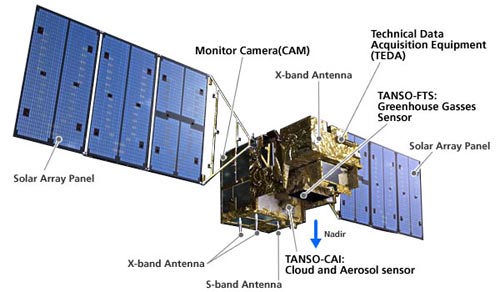Japan launches first-ever environmental Gosat 'Ibuki'
23 Jan 2009
 The Japan Aerospace Exploration Agency today launched the world's first satellite to measure greenhouse gases in the earth's atmosphere, as nations prepare to meet for a new round of climate talks.
The Japan Aerospace Exploration Agency today launched the world's first satellite to measure greenhouse gases in the earth's atmosphere, as nations prepare to meet for a new round of climate talks.
The greenhouse-gases observing satellite, or Gosat, was launched from the Tanegashima Space Centre in southwest Japan at 12:54 pm local time. The satellite will measure the density of carbon dioxide and other gases at 56,000 points around the globe over five years.

"There's a scarcity of data about carbon dioxide and methane gas emissions in jungles in the southern hemisphere and areas above the ocean," Hiroshi Watanabe, Gosat project office manager at Japan's National Institute for Environment Studies, told an interviewer.
The two-metric-ton satellite, named 'Ibuki' (wind), will orbit at an altitude of about 414 miles above the earth, and will "contribute to the international effort toward prevention of (global) warming," the agency said, adding that monitoring greenhouse gases is critical to promoting and supporting measures to mitigate climate change.
Only half the carbon emitted into the atmosphere actually stays there, while the rest is mopped up by forests and oceans acting as "sinks". However, there appears to be a significant carbon sink that is missing.
"Based on our best knowledge about the forest and ocean net sinks, we are 'missing' a carbon sink of 1-3 petagrams," Paul Palmer from the University of Edinburgh and a collaborator on the mission told BBC News. One petagram is equivalent to roughly one million, million kg.
Ibuki will take measurements over most of the Earth's surface of two critical greenhouse gases: carbon dioxide (CO2) and methane (CH4). The satellite will carry two sensors: a Fourier transform spectrometer (FTS), which uses the technique of optical interference to measure greenhouse gases from space, and a cloud and aerosol imager (CAI), which will capture images of the earth's atmosphere and surface, mapping thin clouds and vapour. This data will be used to correct FTS measurements.
Japan's is the first of four satellites expected to be launched globally this year as governments boost efforts to study the cause and predict the impact of climate change, such as higher sea levels caused by polar ice melting.
The National Aeronautics and Space Administration's (NASA) orbiting carbon observatory and Glory satellites as well as the European Space Agency's CryoSat-2 are also scheduled to be launched this year.
The OCO and GOSAT satellites are trying to measure the same quantity. However, their science objectives differ in subtle ways," Palmer explained. "The primary objective of the OCO mission is to find the CO2 sinks. The primary objective of the GOSAT mission is to identify and monitor CO2 sources, to monitor treaty compliance. But GOSAT data will also be used to quantify sinks."
Oceans will rise at significantly higher rates this century than in the last, a study released last week by the US Environmental Protection Agency showed. Almost one-half of the world's 6.7 billion people live near coasts and are "highly vulnerable" to storms and higher sea levels, according to the study.
Japan spent 18.3 billion yen ($205 million) developing the solar-powered Gosat. Mitsubishi Heavy Industries Ltd, Japan's largest heavy-machinery maker, handled the launch.
Some 190 nations plan to meet this year in United Nations-sponsored talks to forge an international treaty to stem climate change. They have agreed to meet a deadline to complete the document in Copenhagen by December.






























